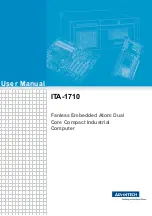
English (GB)
40
12. Detailed descriptions of functionality
12.1 Call-up
12.1.1 Call-up functional description
The call-up function is used for SCADA system communication
via the cellular network. Connection is established when the
SCADA system dials CIU 262. CIU 262 automatically ’picks up
the phone’ and waits for data traffic in the form of Modbus RTU
telegrams.
If legal data traffic is not initiated within one minute, CIU 262
hangs up the line. This silence timeout is active during the whole
communication session. Whenever the SCADA system has
completed the Modbus communication, it hangs up the line. This
is detected by CIU 262, which also hangs up the line, and the
call-up communication session is thereby completed. See fig.
.
Fig. 20
Illustration of a call-up session
12.1.2 SCADA PIN code protection
It is always possible to get read access via Modbus, but if CIU
262 is SCADA PIN-code protected (GeneralStatus register
00029, bit 0: 1), write access requires that the correct PIN code
(ScadaPinCode, register 00011) is written. Writing the correct PIN
code triggers the write access control, and write access is
opened, which can be verified with GeneralStatus, register
00029, bit 1: 1).
For call-up connections with PIN code protection, the
ScadaPinCode register has to be written each time a new call-up
is made.
12.1.3 Call-up options setup
To prepare CIU 262 for Modbus communication with a SCADA
system via a call-up connection, some settings have to be made
via SMS commands:
• Setting a SCADA PIN code:
SETSCADACODE <access code> enables write access
protection.
Default is an empty SCADA PIN code, meaning no protection.
• Activating the SCADA PIN code:
SCADACODE <ON | OFF>.
Default is "Off".
• Selecting the Modbus address:
MODBUSADDR <1-247>
Default value is 231.
To verify the SCADA settings after completion, use the SMS
command "SCADA".
For details about the use of SMS commands, see "CIM 260 SMS
commands", which you can download from Grundfos Product
Center.
12.2 APN
12.2.1 What is APN and Modbus TCP?
An APN connection (Access Point Name) is a wireless, ’always
on’ connection that remains active as long as CIU 262 is within
range of the service. With it, it is possible to establish a wireless
connection to the Internet and thus enable a remote connection to
a SCADA system computer or another PC application.
The APN connection itself takes care of the wireless data transfer
via the cellular network. It plays the same role as ethernet in a
wired network. We will refer to an APN connection as a data
connection, and it also makes use of the TCP/IP protocol, which
enables easy integration with the Internet. The Modbus TCP
protocol is used on the application layer communicating with a
TCP port number (default 502). The difference when compared to
the fieldbus protocol Modbus RTU is the exclusion of the 16-bit
CRC checksum and the adding of a Modbus application program
header as illustrated in fig.
12.2.2 Subscription
You have to select the service provider and the technical solution
that best suits your system, and it must be based on static IP
addressing. You will get the following from the service provider:
• A Subscriber Identity Module (SIM card).
• An Access Point Name (APN), for example "Internet".
• A fixed user name that cannot be changed by the user.
• A fixed password that cannot be changed by the user.
• A static IP address.
Solutions based on a VPN (Virtual Private Network) involve the
use of special routers, for example GRE (Generic Routing
Encapsulation) routers, which you will also get from the service
provider.
Fig. 21
Modbus TCP telegram
T
M
04
49
05
22
0
9
Dialling
Connection established
Hang-up
Modbus communication
Silence timeout after 1 min
without communication
Cellular network,
e.g. SCADA
CIU 262
Hangs up
the line.
Hangs up.
Session
completed.
Call-up
T
M
04
49
07
22
09
Modbus RTU telegram
Modbus TCP/IP data
Modbus application program header
Modbus TCP/IP application data unit
Slave ID
Func
code ID
Data
CRC
Data
Func
code ID
Unit ID
Length
Protocol ID
Transaction ID
















































